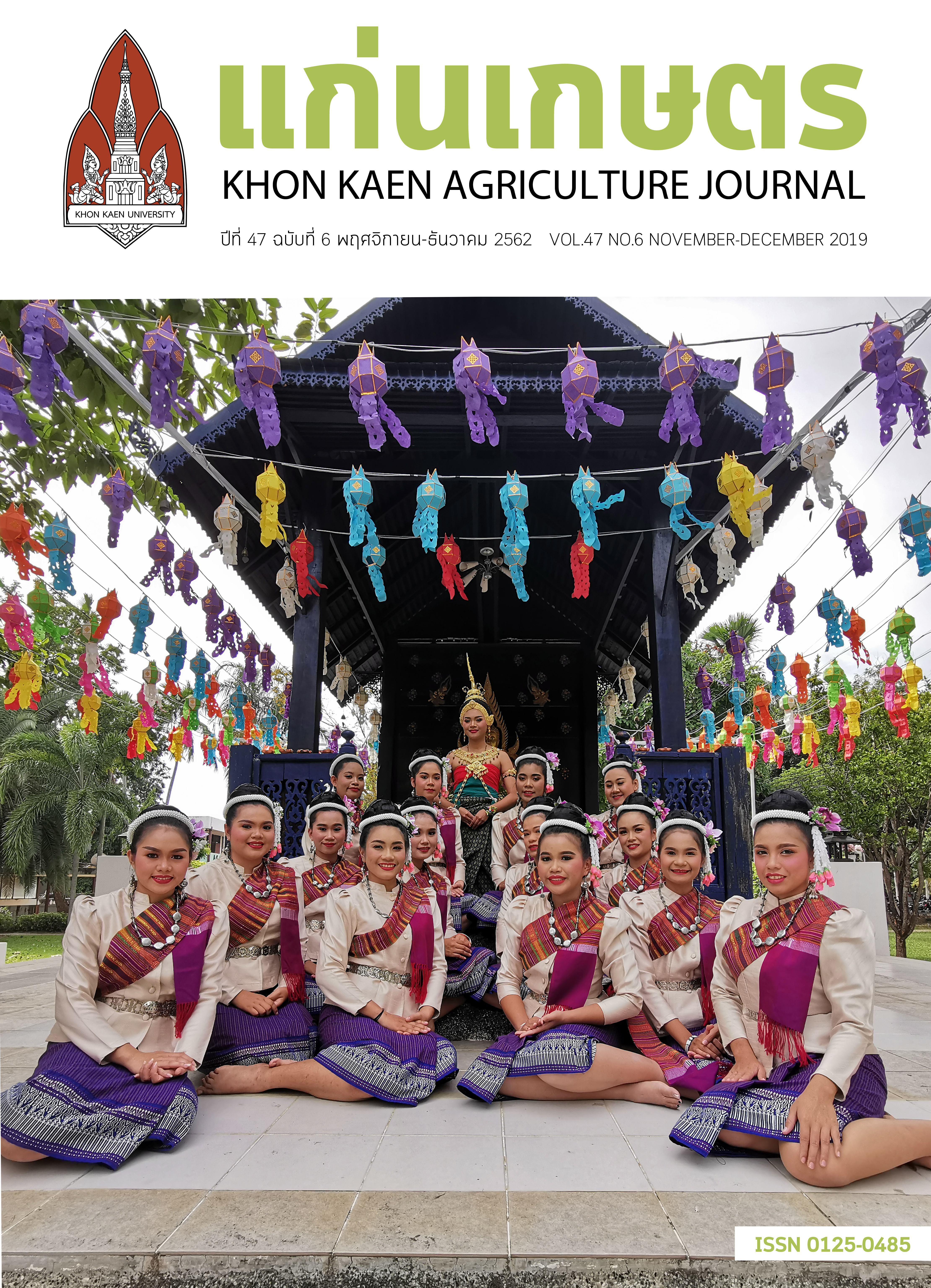ผลของปุ๋ยฟอสฟอรัสต่อลักษณะการดูดซับสังกะสีในดินนาโซดิกพื้นที่ทุ่งกุลาร้องไห้
Main Article Content
บทคัดย่อ
ดินนาโซดิกที่ใช้ปลูกข้าวหอมมะลิพื้นที่ทุ่งกุลาร้องไห้ ได้แก่ ชุดดินพิมาย กุลาร้องไห้ ร้อยเอ็ด ท่าตูม และอุบล ถูกคัดเลือกเพื่อศึกษา 1) การดูดซับและการปลดปล่อยสังกะสีในดินที่ได้รับปุ๋ยฟอสฟอรัสแตกต่างกัน ได้แก่ 0, 0.5, 1.0 และ 2.0 เท่าของอัตราแนะนำสำหรับข้าวหอมมะลิ (6 กก. P2O5 /ไร่) ภายใต้สภาพจำลองการขังน้ำในห้องปฏิบัติการเป็นระยะเวลา 90 วัน และ 2) ผลของปุ๋ยฟอสฟอรัสที่มีต่อข้าวขาวดอกมะลิ 105 ในโรงเรือนประกอบด้วยการไม่ใส่ปุ๋ย การใส่ฟอสฟอรัสในอัตราแนะนำและอัตราที่ทำให้เกิดการดูดซับสังกะสีของดินต่ำที่สุด ผลการศึกษาพบว่า การดูดซับสังกะสีของดินจะเพิ่มขึ้นตามระยะเวลาการขังน้ำและมีค่าสูงสุดในวันที่ 14 ในชุดดินร้อยเอ็ด และชุดดินอุบล ส่วนชุดดินท่าตูมและชุดดินพิมายเป็นวันที่ 30 จากนั้นจะเริ่มปลดปล่อยสังกะสีออกมาจนมีค่าสูงสุดภายใน 60 หลังขังน้ำและมีค่าลดลงอย่างชัดเจนภายใน 30 วันหลังจากที่ปลดปล่อยออกมาสูงสุด การใส่ปุ๋ยฟอสฟอรัสส่งผลต่อความเป็นประโยชน์ของสังกะสีในดินในสภาพน้ำขังโดยแปรปรวนในแต่ละดิน การใส่ปุ๋ยฟอสฟอรัสในอัตรา 3 และ 6 กก. P2O5/ไร่ จะทำให้ชุดดินพิมายและกุลาร้องไห้ดูดซับสังกะสีของดินลดลงและปลดปล่อยสังกะสีออกมามากขึ้น ขณะที่การใส่ปุ๋ ยในอัตราสูงที่ 12 กก. P2O5/ไร่ จะทำให้ชุดดินที่เหลือดูดซับสังกะสีเพิ่มขึ้น การไม่ใส่ปุ๋ยฟอสฟอรัสทำให้น้ำหนักเมล็ดของข้าวในชุดดินอุบล และน้ำหนักแห้งตอซังในชุดดินพิมายต่ำที่สุดอย่างมีนัยสำคัญทางสถิติ การใส่ฟอสฟอรัสในอัตราที่ทำให้ดินดูดซับสังกะสีน้อยที่สุดหรือที่อัตราแนะนำมีผลให้องค์ประกอบผลผลิตของข้าวในดินทั้งสองเพิ่มขึ้นไม่แตกต่างกัน และไม่พบการตอบสนองของข้าวทางด้านผลผลิตในดินที่เหลือ นอกจากนี้การใส่ปุ๋ยฟอสฟอรัสทำให้ข้าวดูดใช้ฟอสฟอรัสเพิ่มขึ้นแต่ไม่มีผลต่อการดูดใช้สังกะสียกเว้นในชุดดินพิมายที่มีการดูดใช้สังกะสีเพิ่มขึ้นอย่างมีนัยสำคัญทางสถิติ
Article Details
เอกสารอ้างอิง
ศูนย์วิจัยข้าวสุรินทร์. 2556. การจัดเขตศักยภาพการผลิตข้าวจังหวัดร้อยเอ็ด. เอกสารวิชาการ กรมการข้าว กระทรวงเกษตรและสหกรณ์. กรุงเทพฯ.
ศูนย์สารสนเทศการเกษตร. 2557. ข้อมูลเอกภาพ ภาคตะวันออกเฉียงเหนือ. สำนักงานเศรษฐกิจการเกษตร กระทรวงเกษตรและสหกรณ์. กรุงเทพฯ.
Agbenin, J.O. 1988. Phosphate induced retention in tropical semi-arid soil. European J. Soil Sci. 49: 693-700
Alam, M.G.M., G. Allinson, F. Stagnitti, A. Tanaka and M. Westbrooke. 2002. Metal concentrations in rice and pulses of Samta village, Bangladesh. Bull. Environ. Contam. Toxico. 69: 323-329.
Alloway, B.J. 2008. Zinc in soils and crop nutrition, 2nd eds. International Zinc Association Brussels, Belgium and International Fertilizer Industry Association Paris, France.Cakmak, I. 2008. Enrichment of cereal grains with zinc: Agronomic or genetic biofortification. Plant Soil 302: 1-17.
Dobermann, A. and T. Fairhurst. 2000. Rice: Nutrient disorders and nutrient management. Potash and phosphate institute (PPI), Phosphate institute of Canada (PPIC) and International rice research institute (IRRI).
Duangpatra, P. 1998. Soil and climate characterization of major cassava growing area in Thailand. In. Howeler, R.H. and Kawano, K., eds. Cassava breading and agronomy research in Asia. Proccedings of regional workshop held in Rayong, Thailand.
Fan, D. and L.Q. Chen. 1997. Computer simulation of grain growth using a continuum field model. Acta Mater 45: 611-622.
Forno, D.A., S. Yoshida and C.J. Asher. 1975. Zinc deficiency in rice. I. Soil factors associated with the deficiency. Plant Soil 42: 537-550.
Freundlich, H.M.F. 1906. Over the adsorption in solution. J. Phys. Chem. 57: 385 – 470.
Hararah, M.A., F.L. Nasir, T.E. Hasan and A.H.L. Muhtaseb. 2012. Zinc adsorption-desorption isotherm: possible effects on the calcareous vertisol soils from Jordan. Environ. Earth Sci. 65: 2079-2085.
Huang, B., Z. Li, J. Huang, L. Guo, X. Nie, Y. Wang, Y. Zhang and G. Zeng. 2014. Adsorption characteristics of Cu and Zn onto various size fractions of aggregates from red paddy soil. J. Hazard. Materials 264:176– 183
Inboonchuay, T., A. Suddhiprakarn, I. Kheoruenromne, S. Anusontpornperm and R.J. Gilkes. 2016. Amounts and association of heavy metal in paddy soils of the Khorat basin, Thailand. Geoderma Regional 7: 120-131.
Kabata-Pendias, A. 2004. Soil plant transfer to trace element an environment issue. Geoderma 122: 143-149.Kashem, M.A. and B.R. Singh. 2001. Metal availability in contaminated soils: I. Effect of flooding and organic matter on changes in Eh, pH and solubility of Cd, Ni and Zn. Nutri. Cyc. Agroeco. 61: 247-255.
Kaya, C. and D. Higgs. 2002. Response of tomato (Lycopersicon esculentum L.) cultivar for foliar application of zinc when growth in sand culture at low zinc. Scientia Hort. 93: 53-64.
Khaokaew, S. 2010. Speciation and release kinetic of cadmium and zinc in paddy soils. Ph.D. Dissertation. University of Delaware, USA.
Mandal, B. and L.N. Mandal. 1990. Effect of phosphorus application on transformation of zinc fraction in soil and on the zinc nutrition of lowland rice. Plant and Soil 121: 115-123
Marschner, H. 1993. Zn uptake from soil. In A.D. Robson ed. Zinc in Soil and Plants. Kluwer Academic Publishers. pp. 59-78.
Pandey, M., N. Pandey, G.C. Pathak and C.P. Sharma. 2006. Zinc is critically required for pollen function and fertilization in lentil. J. Trace Element Med. Biolo. 20: 89-96.
Perez-Novo, C., A. Bermúdez-Couso, E. López-Periago, D. Fernández-Calviño and M. Arias-Estévez. 2011. Zinc adsorption in acid soils, Influence of phosphate. Geodema 162: 358 – 364.
Robson, A.D. 1993. Zinc in soil and plants. Kluwer Academic Publisher.Saeed, M. 1977. Phosphate fertilization reduces zinc adsorption by calcareous soils. Plant Soil 48: 641-649.
Saleque, M.A., M.J. Abedin, Z.U. Ahmed, M. Hasan and G.M. Panaullah. 2001. Influences of phosphorus efficiency on the uptake of nitrogen, potassium, calcium, manganese, sulfur and zinc in lowland rice varieties. J. Plant Nutri. 24: 1621-1623
Shahane, A.A., Y.S. Shivay, D. Kumar and R. Prasanna. 2018. Interaction effect of nitrogen, phosphorus, and zinc fertilization on growth, yield, and nutrient contents of aromatic rice varieties, J. Plant Nutri. 41: 2344-2355.
Verma, T.S. and R.S. Minhas. 1987. Zinc and phosphorus interaction in a wheat-maize cropping system. Fertilizer Res. 13: 78-86.Vodyanitskii, Y.N. 2010. Zinc forms in soils (review of publications). Eurasian Soil Sci. 43: 269-277.
Xiang. H.F., H.A. Tang and Q.H. Ying. 1995. Transformation and distribution of forms of zinc in acid, neutral and calcareous soils of China. Geoderma 66: 121-135.
Zhao, K. and H.M. Selim. 2010. Adsorption-desorption kinetics of Zn in soil: influence of phosphate. Soil Sci. 175: 145-153.
Zhu, Y.G., S.E. Smith and F.A. Smith. 2001. Zinc (Zn)-phosphorus (P) interaction in two cultivars spring wheat (Triticum aestivum L.) differing in P uptake efficiency. Annual Botany 88: 941-945.


